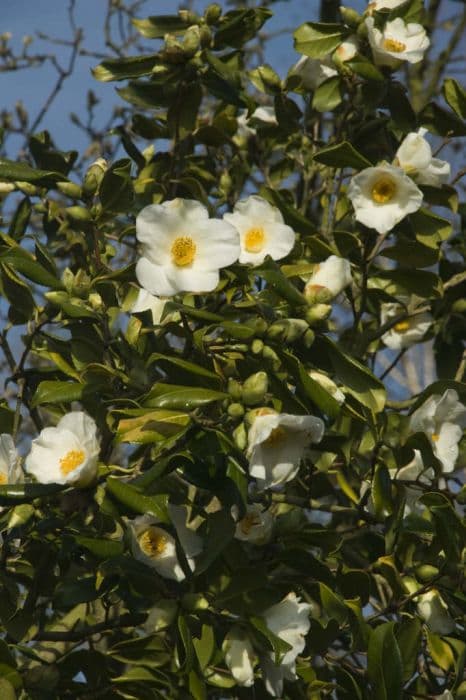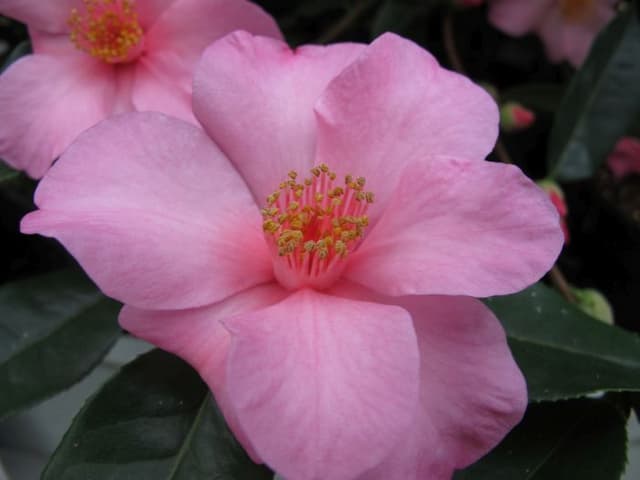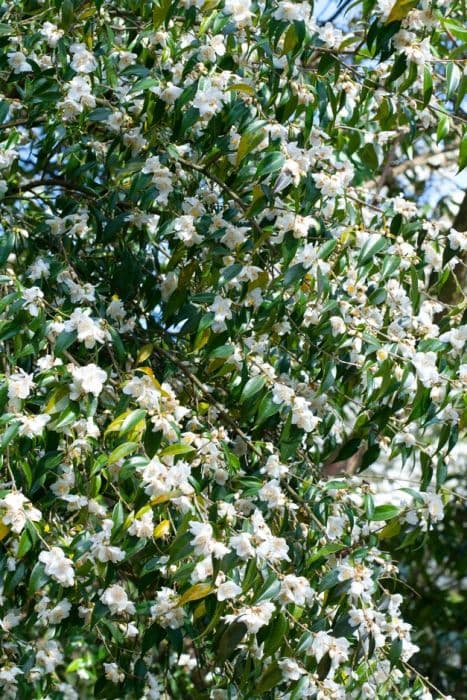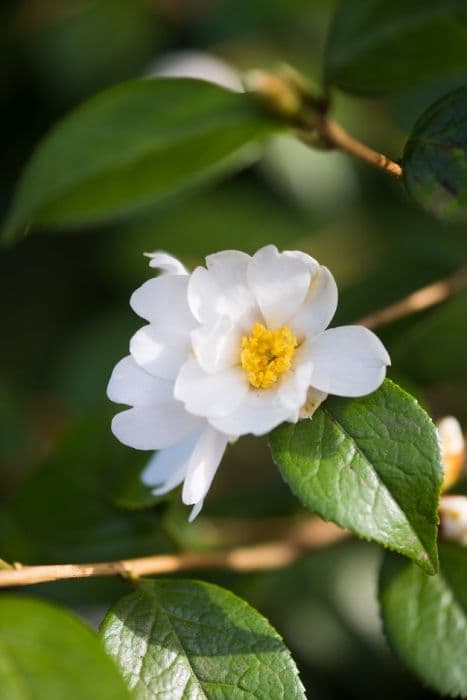Francis Hanger Camellia Camellia × williamsii 'Francis Hanger'

ABOUT
Camellia 'Francis Hanger' is a popular hybrid flowering plant known for its attractive ornamental features. This plant boasts glossy, dark green leaves that provide a lush, evergreen backdrop throughout the year. The standout characteristic of this variety is its blooms, which tend to flower in the cooler months when much else in the garden is dormant. The blossoms are large and showy, often resembling sumptuous rosettes. The flowers feature a profusion of soft pink petals that are imbued with a delicate texture and may have a tendency to shade to a lighter pink or white towards the edges. The petals are often arranged in a formal, symmetrical shape, and the flowers exude a subtle, pleasing fragrance that can add an aromatic dimension to their surroundings. In the center of each bloom, a cluster of contrasting golden-yellow stamens typically sits, adding a striking touch to the flower's overall appearance. Camellia 'Francis Hanger' grows as an upright shrub with a balanced, well-branched structure that lends itself to being an elegant specimen in a garden setting.
About this plant
 Names
NamesSynonyms
Williamsii Camellia, Hybrid Camellia
Common names
Camellia × williamsii 'Francis Hanger'.
 Toxicity
ToxicityTo humans
The Camellia Francis Hanger is not considered poisonous to humans. There are no well-documented cases of toxicity from ingesting this plant, and it's generally regarded as safe. However, it's always best to avoid consuming parts of ornamental plants due to their potential to cause gastrointestinal discomfort or other non-toxic reactions in some individuals.
To pets
The Camellia Francis Hanger is generally considered non-toxic to pets, including dogs and cats. There should be no symptoms of poisoning if a pet ingests parts of this plant, as it is not known to contain any harmful substances. However, as with humans, it is still best practice to prevent pets from eating ornamental plants to avoid any potential stomach upset or other non-toxic reactions.
 Characteristics
CharacteristicsLife cycle
Perennials
Foliage type
Evergreen
Color of leaves
Green
Flower color
Pink
Height
6-10 feet (1.8-3 meters)
Spread
4-8 feet (1.2-2.4 meters)
Plant type
Shrub
Hardiness zones
7-9
Native area
Japan
Benefits
 General Benefits
General Benefits- Ornamental Value: Camellia × williamsii 'Francis Hanger' is acclaimed for its beautiful flowers, which add aesthetic appeal to gardens and landscapes.
- Year-Round Interest: With its evergreen foliage, this plant maintains visual interest throughout the year, even when not in bloom.
- Shade Tolerant: This camellia can thrive in partially shaded areas, providing flexibility in garden design and plant placement.
- Drought Resistance: Once established, it has a level of drought resistance, which can be beneficial in drier climates or during water restrictions.
- Low Maintenance: It requires minimal pruning and care, making it an ideal choice for both novice and experienced gardeners.
- Wildlife Attraction: The flowers can attract pollinators such as bees, benefiting the local ecosystem.
- Cold Tolerance: This variety typically has a good tolerance to colder temperatures compared to other camellias, broadening its range of suitable planting zones.
 Medical Properties
Medical PropertiesThis plant is not used for medical purposes.
 Air-purifying Qualities
Air-purifying QualitiesThis plant is not specifically known for air purifying qualities.
 Other Uses
Other Uses- Camellia x williamsii 'Francis Hanger' can be used as a natural dye for fabrics, providing a range of colors from greens to browns depending on the mordant used.
- Leaves from the Camellia can be utilized in composting to add nutrients as they break down, enhancing soil fertility.
- The fallen petals of Camellias can be scattered on the surface of pots to add a decorative mulch for container gardens.
- Sturdy Camellia branches may be employed as natural stakes for supporting other plants in the garden.
- Artists sometimes use the Camellia petals as a component in botanical papermaking, adding texture and color to the paper.
- Camellia blossoms can be used for flower pressing, often included in craft projects or as a method for preserving garden memories.
- Interesting shapes of Camellia leaves and blooms can be used as stencils for painting or creating patterns in art projects.
- During certain festivals or cultural events, Camellia flowers may be floated in bowls of water as a decor element, symbolizing transient beauty.
- Photographers may choose Camellia plants as subjects for botanical photography due to their exquisite flower forms and vibrant colors.
- Cooking enthusiasts sometimes crystallize Camellia petals with sugar to create edible decorations for cakes and pastries.
Interesting Facts
 Feng Shui
Feng ShuiThe Camellia is not used in Feng Shui practice.
 Zodiac Sign Compitability
Zodiac Sign CompitabilityThe Camellia is not used in astrology practice.
 Plant Symbolism
Plant Symbolism- Adoration and Devotion: The Camellia flower, commonly known as Camellia, often symbolizes deep affection and steadfastness. It is given as a gift to express one's admiration or deep love for someone.
- Perfection and Excellence: Due to its perfectly arranged petals and lush appearance, the Camellia represents the ideal of perfection or reaching a state of excellence.
- Refinement and Perfection: The flower is often associated with refinement and perfection in life, symbolizing the aspiration for personal betterment and sophistication.
- Longevity and Faithfulness: Camellias are evergreen plants that can live for many years. As such, they are associated with long-lasting life and relationships, as well as unchanging fidelity.
- Desire or Passion: Red Camellias, in particular, are often representative of desire or deep passion. Giving a red Camellia can signify a strong longing or heartfelt emotion toward someone.
 Water
WaterThe Williamsii Camellia, commonly known as 'Francis Hanger,' should be watered deeply to ensure the root system is adequately moistened, usually once a week. The frequency of watering may increase during dry spells or hot weather, potentially requiring additional watering sessions. Each watering should provide enough water to soak the soil to a depth of at least 8 inches, which could be around 1-2 gallons for a medium-sized shrub. It is important to avoid waterlogging, so ensure good drainage and reduce watering during the winter months when the plant is not actively growing.
 Light
LightWilliamsii Camellias require dappled sunlight or partial shade to thrive. Direct, intense afternoon sunlight can damage the foliage and flowers, while too much shade can reduce flowering. An ideal location would provide morning light with protection from strong afternoon rays, such as a spot under a lightly-canopied tree or on the north or east side of a building.
 Temperature
TemperatureWilliamsii Camellias prefer moderate temperatures and should be ideally kept between 60°F and 80°F. They can withstand short periods of colder weather down to around 20°F (-6°C) but need protection from strong winter winds and frost. Similarly, prolonged exposure to temperatures above 90°F can stress the plant and should be avoided.
 Pruning
PruningPrune the Williamsii Camellia to maintain shape and promote vigorous growth, usually immediately after flowering has finished in late winter or early spring. Remove any dead or diseased wood, thin out crowded branches, and cut back growth to encourage new shoots. Pruning every year or every other year is typically sufficient.
 Cleaning
CleaningAs needed
 Soil
SoilCamellia × williamsii 'Francis Hanger', commonly known as Williamsii Camellia, thrives in acidic, well-draining soil with a pH of 5.5 to 6.5. A mix of 2/3 acidic organic matter such as pine bark or peat moss, and 1/3 sand or perlite is ideal to create the right conditions for root growth and health.
 Repotting
RepottingWilliamsii Camellias should be repotted every 2 to 3 years to refresh the soil and accommodate root growth. It is best done in late winter or early spring before new growth starts.
 Humidity & Misting
Humidity & MistingWilliamsii Camellia prefers moderate to high humidity levels, ideally between 50% and 70%. Consistently high humidity encourages healthy foliage and flower development without additional watering needs.
 Suitable locations
Suitable locationsIndoor
Use acidic soil, moderate water, and bright, indirect light.
Outdoor
Plant in partial shade, acidic soil, and shelter from cold winds.
Hardiness zone
7-9 USDA
 Life cycle
Life cycleThe life of the Camellia × williamsii 'Francis Hanger', commonly known as Camellia, begins with seed germination, which requires well-drained, acidic soil and can take several weeks to months. The seedling stage includes the emergence of the first true leaves and establishment of a root system. As it matures into a young plant, the camellia undergoes vegetative growth, developing a woody stem and evergreen leaves. Upon reaching maturity after several years, it enters the flowering stage, typically blooming in late winter to early spring with showy, ornamental flowers that attract pollinators. After pollination, it produces fruit in the form of a dry capsule containing seeds, which, when mature, can be dispersed to begin a new generation. Throughout its life, the camellia requires careful pruning and maintenance to manage its shape and promote healthy growth cycles.
 Propogation
PropogationPropogation time
Spring-Early Summer
The most popular method of propagation for the Camellia × williamsii 'Francis Hanger', commonly known as a hybrid Camellia, is through semi-hardwood cuttings. This process typically begins in late summer to early fall. To propagate, a 4 to 6-inch (10 to 15 centimeter) cutting of new growth that has started to harden is selected. The lower leaves are removed, and the base of the cutting is dipped in a rooting hormone to encourage root development. The cutting is then placed in a pot filled with a mixture of peat and perlite or a similar free-draining propagation medium. It is important to maintain a humid environment around the cutting, which can be achieved by covering the pot with a plastic bag or placing it in a propagator. Cuttings generally root in a few months if kept in consistent warmth and indirect light.









